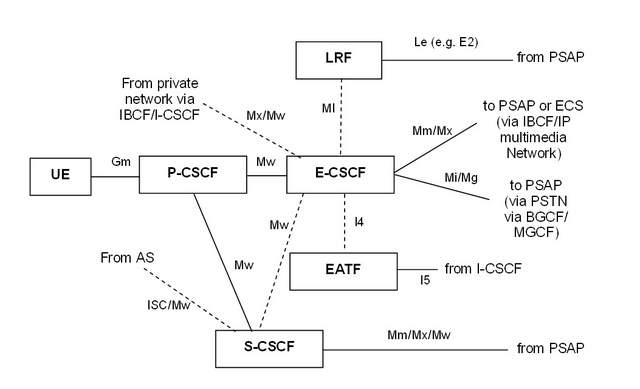Non Voice Emergency Service (NOVES ) allows the UE to use other media and communication types other than voice and GTT during an IMS emergency session when the network supports IMS emergency service and the UE also supports other media or communication types.
In case of Emergency session over IMS, Emergency sessions should be prioritized over non-emergency sessions by the system.
Emergency Service is not a subscription service and therefore, when the UE has roamed out of its home network, emergency services shall not be provided by the home network and shall be provided in the roamed-to network if the roamed-to network supports emergency sessions. If a UE has sufficient credentials, it shall initiate an emergency registration with the network (requiring the involvement of the home network). The CSCFs providing service for emergency sessions may be different from the CSCFs involved in the other IMS services. If the registration fails, the UE may attempt an anonymous emergency call.
When a UE performs an emergency registration, barring and roaming restrictions are ignored.
If the UE has location information available, the UE shall include the location information in the request to establish an emergency session. The location information may consist of network location information, that is the Location Identifier, and/or the Geographical location information.
The P‑CSCF may query the IP‑CAN to obtain location identifier.
In can of IMS emergency service the UE should be able to access the IP-CAN without sufficient security credentials.
IMS Emergency Service Architecture

NOTE:
P‑CSCF, EATF and E-CSCF are always located in the serving network.
Based on operator policy, the E‑CSCF can route the emergency IMS session to the PSAP via an ECS
UE
The UE should able to detect emergency session establishment request. If an incoming call has an emergency call back indicator present, the UE shall detect the incoming PSAP call back session establishment request.
Proxy‑CSCF
Proxy‑CSCF handle registration requests with an emergency registration indication like any other registration request, except that it may reject an emergency registration request if the IM CN subsystem that the P‑CSCF belongs to can not support emergency sessions for the UE.
For non-roaming subscribers, the P-CSCF may forward an emergency session to an S-CSCF if so instructed by operator policy or local regulation.
Emergency‑CSCF
Emergency‑CSCF receives an emergency session establishment request from a P‑CSCF or an S-CSCF. If the UE does not have credentials, a non-dialable callback number shall be derived where required by local regulation.
If location information is not included in the emergency request or additional location information is required, the E‑CSCF may request the LRF to retrieve location information as described in clause 7.6 Retrieving Location information for Emergency Session.
Location Retrieval Function (LRF)
Location Retrieval Function (LRF) is responsible for retrieving the location information of the UE that has initiated an IMS emergency session.
LRF utilizes the a Routing Determination Function (RDF) to provide the routing information to the E‑CSCF for routing the emergency request.
Serving-CSCF
When the S‑CSCF receives an Emergency Registration, the S‑CSCF determine the duration of the registration by checking the value of the Expires header in the received REGISTER request and based on local regulation or operator policy of the serving system.
MGCF
The MGCF may:
- Determine based on the operator policy if an incoming call form the PSTN is for the purpose of PSAP call-back. The operator policy decision may be based on that the call is from an emergency centre or from a PSAP and/or any other information made available to the MGCF.
- Include a “PSAP call-back indication” in the SIP session establishment request if an incoming call is determined to be for the purpose of PSAP call-back.
Reference
3GPP 23.167 – IP Multimedia Subsystem (IMS) emergency sessions
